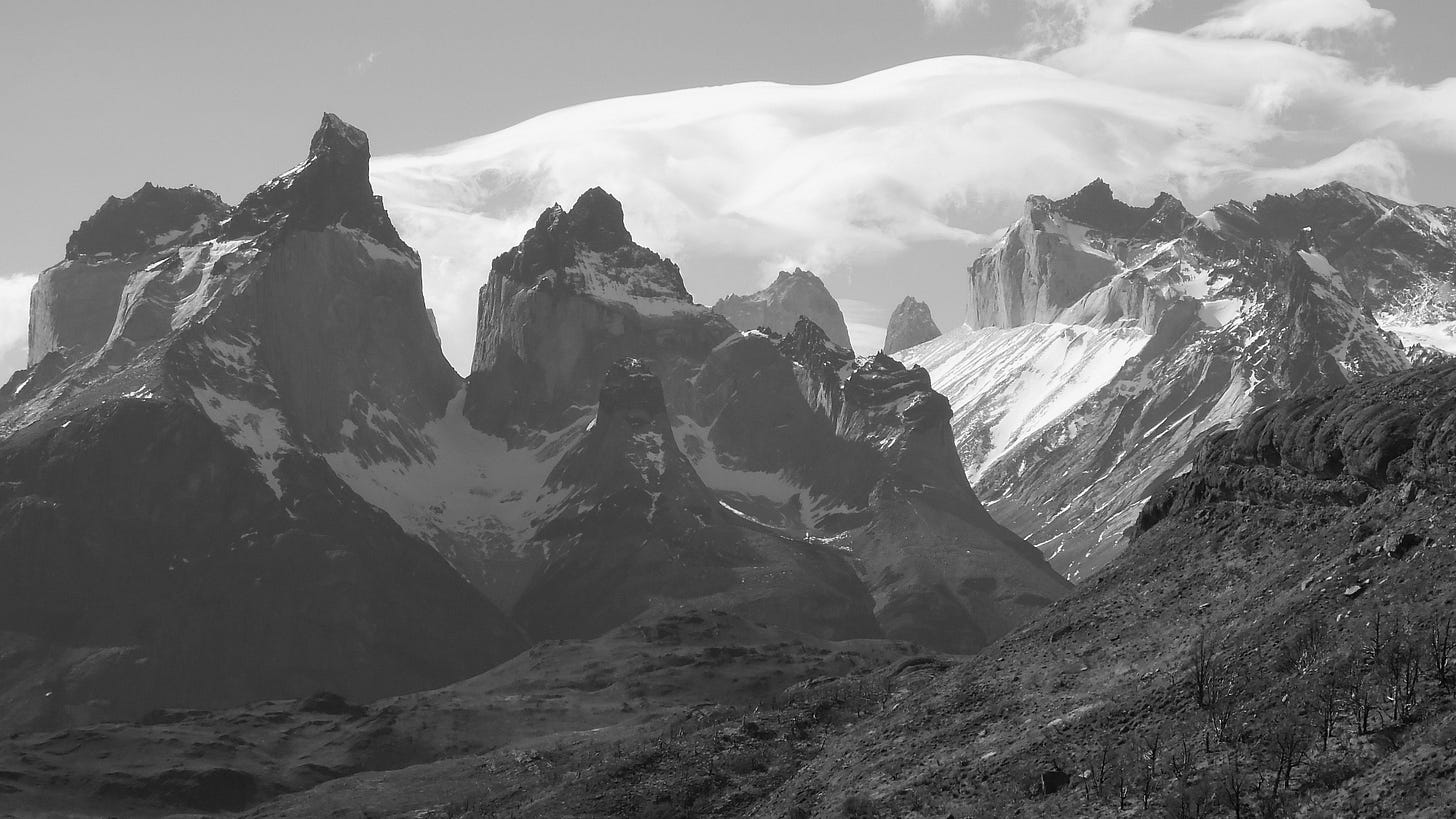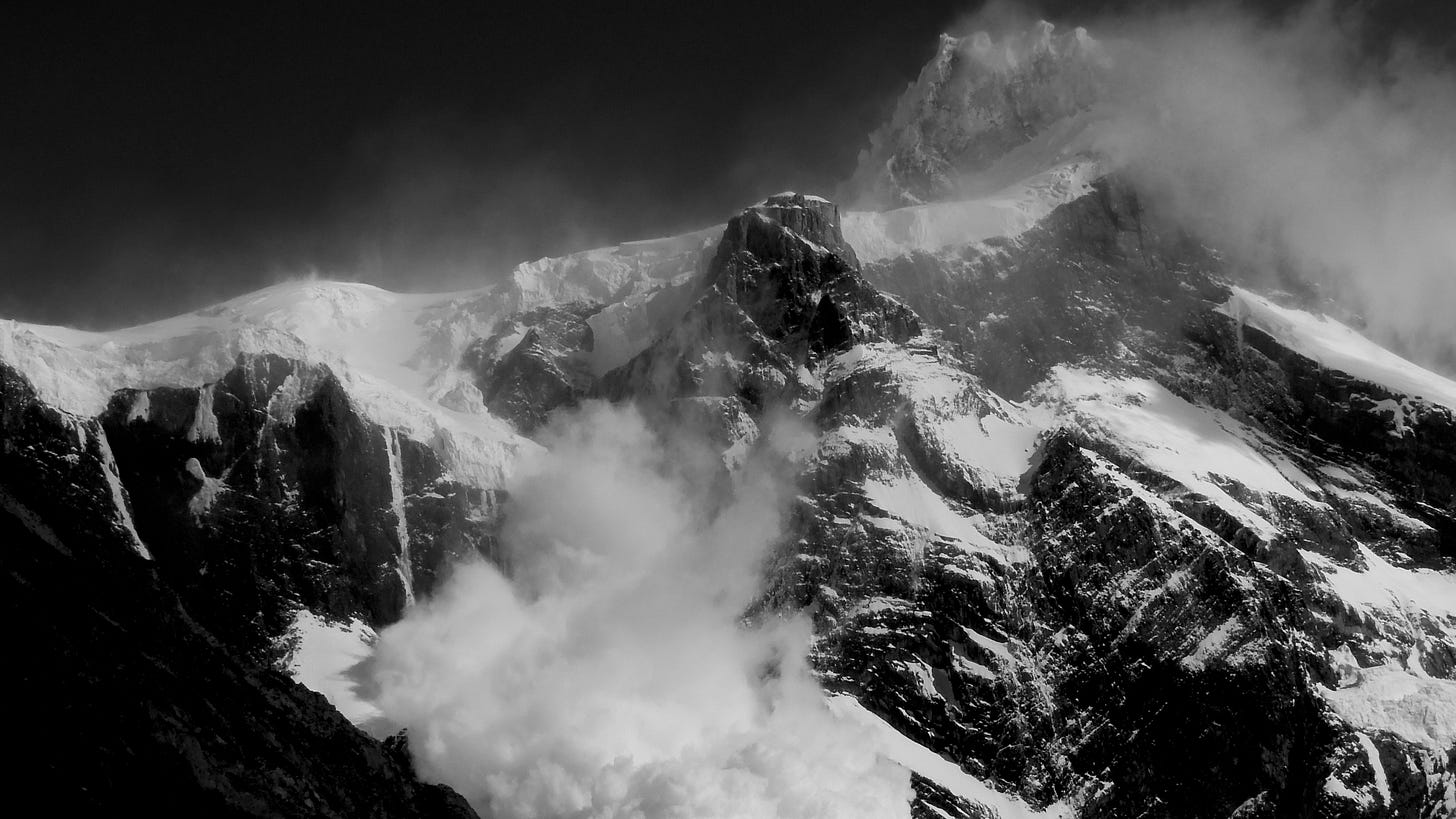In the Chilean slice of Patagonia, home to the outlandish wilderness at the bottom of the world, there’s one particularly celebrated hike. Reaching the summit isn’t exactly a herculean task, though it does require an ascent of about 1,000 meters, partly on rocks, partly on greens, partly on what can loosely be described as trails. Base to summit stretches about eighteen kilometers. At a brisk pace the hike takes about eight hours. And it is best to descend long before sunset.
When I took the most visited trail in this section of Patagonia, my day began with a chilly, sideways rain, the midafternoon came with a blistering heat, and the evening brought a surprising calm that somehow felt threatening—with fierce, swirling winds my primary companion. The cliché about having four seasons in one day is used to describe many places in the world—but this is the only place where I’ve felt those words to be accurate. Patagonia gives you a little snow to go with your blinding sun, a little sun to go with your rain, a little rain to go with your snow. And the speed with which the weather shifts prompts, in me at least, an insouciance about the current conditions. It is raining, yes, but it will stop soon enough, just as any emotion that arises during your day—anger, joy, sadness, elation, loneliness, annoyance—always dissipates soon enough, too, with the disappearance as swift as the appearance.
Although to simply look at the mountain is a bit of a challenge. Most likely, you’ll need to reach Santiago first, and then take a flight to Punta Arenas, the southernmost city in South America—with its preposterous winds, absence of ozone, and location just a smidge north of Antarctica. From that windswept spot, it is three hours by bus to Puerto Natales, a small town that’s nuzzled along the shore, and about ninety minutes away from Torres del Paine National Park. Taking eight hours to hike the mountain, by this point, seems almost agreeable.
And my sense is that the long journey affects the hike, shaping the experience and interpretation of the mountain. A feeling of discovery can be electrifying, even enchanting, but it only emerges once you’ve passed beyond what’s already comfortable, or already known, whether that means overcoming a physical challenge or dealing with a psychological constraint or crossing a distant frontier. There’s a necessity to travel, to leave what’s expected, which creates the conditions that are conducive to a transformation. Each stage—the planes, the buses, the cars, the hikes—took me a step farther from home, and obviously increased the length of my return trip, so that the journey itself acts as an all too necessary threshold.
And the physical thresholds of distance and difficulty very quickly become psychological thresholds: a departure from what’s comfortable and familiar is always, by rather obvious definition, an arrival. Which might be frightening. Or enlivening. Perhaps confusing. The only guarantee is that a novel environment brings an intensity of sensation, a focus that’s unavailable in the stagnant, habitual environment that comprises most of life. And that focus can certainly be addicting—with adventure, travel, and danger a surefire method of prompting a vertiginous sensation, one that’s vivid and intense and total. To have your perceptions restricted to your surroundings is also to escape the incessant pings and rings and alerts of contemporary life, it is to live, for just a moment, in a perpetual present, without any past or future. The length and trials of the journey are necessary to reach this point—you need the toil and sweat of pursuit to actually appreciate the finale, just as you need to slog through the background chapters of a novel to reach the climax. Without that foundation, the finale won’t have the same effect. And if the summit in Patagonia had been only steps from my bed, I would eventually become accustomed to the view.
Thinking about thresholds, and about the rewards that redound when they’re crossed, reminds me of a different time, which appears to me as part of the blurry past. These memories comes from when I lived along a beach just outside of New York City. Most weekends brought crowds from the city and packed the shore, but there were times—a Tuesday morning at dawn, for instance—when the entire beach would be empty.
The ocean likes to slap and cut and scare those nearest to the shore, but that spot, too, can be considered a threshold, with the ocean much gentler if you’re farther away from the shoreline—however deceptive, I should add, is that gentleness. This results in the most violent crashes right at the meeting of water and beach, and makes swimming a bit farther out, on those quiet mornings, a much calmer experience, one that’s buoyed by the upward and downward slop of the ever-increasing waves.
Each stroke would bring me farther from land, and there was always this wonderful mixture of excitement and fear while I swam away from the beach, as I knew that the distance behind me—the distance home—kept growing. Swimming in the morning carried me toward the rising sun, with the city’s skyline and the tiny homes along the beach receding behind me. And I didn’t have to swim too far to reach the steep undulations that are always present in the Atlantic.
Eventually, I would stop, tread water, and simply float, curious about the depth of the sea floor below my feet, feeling how my body ascended and descended with the ocean. Apart from the steady churn of waves, and the occasional splash from my arms, the sunrise was its own silent threshold between night and day, while the louder and fiercer and more unforgiving threshold was closer to shore—one that I had already passed, and would pass, I certainly hoped, once again. I could see, in the distance, the tiny city ablaze in oranges and reds, until the backside of a large wave would snatch the land from view.







“There’s a necessity to travel, to leave what’s expected, which creates the conditions that are conducive to a transformation.” Amen. I didn’t experience my first plane flight until my mid twenties. Even now, I’m a nervous flier. But I fly anyway, after a few IPA’s to settle things. Because my wife loves travel, and she has taken me to the jungles and mangroves of Costa Rica, the highlands of Scotland, wine caves in Tuscany, and the buskers and pubs of Grafton Street in Ireland. Even the top of the Empire State Building, and the literary walk of Central Park. I have not explored Patagonia, but thanks to your beautiful writing and photography, I get a sense. Many thanks, Charles. You are are a fine writer.